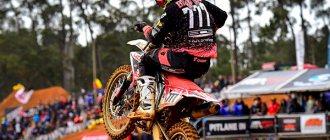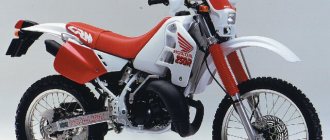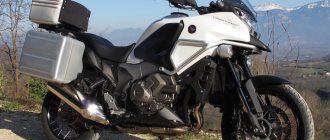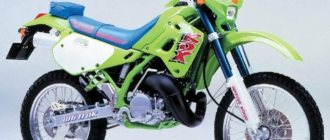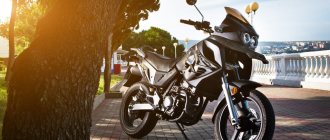Enduro can easily be called the “brother” of motocross, since racing in both disciplines takes place off-road, inevitably involves overcoming obstacles and requires significant physical preparation from athletes. And even the motorcycles used in both disciplines seem almost identical at first glance. However, upon closer examination, it quickly becomes clear that there are much more differences between the directions.
general information
So what is enduro? The essence of the discipline is easy to understand by the name, which comes from the English word endurance - “endurance”. Indeed, enduro competitions are a real test of endurance, both for the rider and the equipment, since most of any race takes place over rough terrain, strewn with a large number of natural and artificially created obstacles, which participants have to overcome at the fastest possible pace. Racers start in groups of 2-3 people at intervals of 1 minute.
Competitions can be one- or multi-day (up to 6 days), but no more than 6-7 hours a day. These include:
- Road competitions with observance of traffic rules, passing checkpoints and the accrual of penalty points for being late. Information about the time and points awarded is noted on the participant’s control card.
- Additional tests: cross-country running along the main highway, and acceleration - passing a closed straight section of the highway at maximum speed.
The course for road competitions is a closed curve and may include sections of public roads (up to 30% of the total length) that are not closed to the traffic of other vehicles. When passing them, riders must comply with traffic rules. For each day of competition, a different version of the route is prepared. On the final day of the multi-day competition, a final cross-country race of 10-18 km is held.
In addition to a separate sports direction, currently the word enduro can also mean ordinary amateur off-road racing “for oneself”, that is, without any competitive elements.
Continuation. Started in No. 12/2007
The following review is an attempt to give an express description of used Japanese-made motorcycles of a minimum price niche that enter the Ukrainian market. Taking into account that there is minimal demand for cubic capacity up to 200 cm3, small cubic capacity devices will not be considered in this review. Motorcycles with not yet very common engines and water cooling will be highlighted in the text. If the cubic capacity is not indicated, this means that under this name there is a different-sized “family” of motorcycles.
Sports enduro
If you only want to stir up mud, stir up water and raise columns of dust, then this is your choice. Almost all motorcycles that belong to this “breed” are actually “cross bikes” with a derated engine and headlight to increase their service life. These motorcycles often do not have anything extra, such as an electric starter. It is important to understand that this class is not a choice for beginners! To have a “friendly relationship” with sports enduro, you need to be an experienced off-road pilot. Motorcycles of this class usually do not have “stops” and “turns” (exceptions are “internal Japanese”), so although it can be registered with the MREO, it is not possible to pass a technical inspection and ride on public roads. The fate of its owner is off-road food trucks and transportation on a trailer or by bus to “places of military glory.” This also includes “crazy” two-stroke bikes: Honda CRM and Kawasaki KDX . They have a full set of lighting equipment and can be registered and even driven on public roads. Let the owner decide how justified this step is. Personally, I doubt the “pleasure” that a motorcycle with a particularly evil engine and a cross-style short throttle handle can bring in city traffic jams or “fast” asphalt turns.
There are many four-stroke “250s” in this class: Suzuki DR-Z 250 , Honda XR250R , Yamaha TT250R , Kawasaki KLX250 (“watery”). But sports-tuned rigid suspensions that are unable to handle road unevenness, a small gas tank, narrow and hard sports saddles and symbolic headlights are not a very good combination over more or less significant asphalt distances. These features bring these bikes into this category rather than the next. Despite certain inconveniences, the opportunity to independently travel 200-300 km to the place of future exploits is hard to underestimate. Tourist versions of some of them are more suitable for long-distance raids, but we will talk about them later.
The most popular 400s are the Suzuki DR-Z400E and Yamaha WR (both dropsy). Sports uncompromising projectiles, for off-road use only. If you like one of them, and you are able to realize their capabilities, be prepared to invest money in a motorcycle.
Very rarely, but still sometimes in Ukraine there are “hard” 600s : Honda XR650R (“dropsy”), Yamaha TT600 , Kawasaki KLX600 (“dropsy”). The first of them has such a loaded engine (62 hp) that it requires an oil change after one thousand kilometers (!). The devices are for very experienced drivers. Without regular exercise in the gym, there is no point in approaching the “six hundredth” kickstarter.
Soft enduro, or soft enduro
This “breed” includes motorcycles that manufacturers have tried to adapt for both on-road and off-road use. A truly universal technique, the heir to the scrambler concept of the 1960s, from which (one might say) the history of the enduro class began. However, we “pay” for versatility by the inability to move quickly (rally style) off-road. Let me remind you that speed is a relative concept. Moving at a speed of 60 km/h along a path in an unfamiliar forest (and each of the devices listed below is capable of this), those who wish will receive such an amount of adrenaline that it will not seem like enough.
The “250-k” class is opened by the Yamaha TT-R 230 and XT225 (Serow) and the Honda XL250 Degree (dropsy). In fact, these are not exactly enduro, but almost the only representatives of a rare breed of mountain motorcycles. If you look closely at these devices, trial features will become noticeable - a shortened wheelbase, a large fork offset, a low saddle, and relatively small suspension travel. Another common feature in the transmission is a very short first gear, tuned for mountains. These motorcycles are designed for relatively quiet off-road riding. But trialling or driving several hundred kilometers on asphalt is not a problem for them, and they are very convenient in the city. The XT has a simple and undemanding two-valve air-cooled engine that simply doesn't have anything to break. Its competitor is a kind of Honda factory self-propelled gun: it has a frame from the XR (until ’95), suspension and a modern two-shaft water-cooled engine from the AX-1. “Degree” is a full-fledged two-seater motorcycle, even the passenger’s legs do not interfere with the driver (if both are no more than 175 cm tall - editor’s note).
Also included in this class is the Honda NX250 (dropsy), which was sold in Europe until 1996. With the exception of a frame shared with the "urban Japanese enduro" Honda AX-1, a rally-style body kit and minor gearbox quirks (which consequently made it a less extreme environment), this bike is not much different from the XL250 Degree.
The Honda XR400 is an interesting combination of the compact chassis of the 250 and a high-torque and reliable 400 cc engine, which, even in the mountains, rarely requires a lower gear after third gear. The suspensions are quite weak, most likely designed for a quiet ride rather than off-road use. Despite all this, only domestic Japanese equipment has complete lighting equipment.
Suzuki DR-Z400S (dropsy) is the undisputed leader of the Ukrainian enduro market. An almost perfectly balanced device that allows you not to deny yourself anything off-road and at the same time feel confident on the highway and in the city.
The Honda XR650L doesn't share a single nut with the very similar-named XR650R. A very interesting motorcycle: it has a relatively quiet engine from the Dominator, and at the same time uncompromising suspension from the cross-country CR. The stock version is equipped with a spartan sports body kit. But, given its popularity for travel and long trips, a whole bunch of tuning is made for it - from a more capacious tank and a wide saddle, to Baja-style headlights and luggage systems.
The Yamaha XT600E traces its origins to the legendary winner of the first Dakar, the XT500. It has a simple and reliable, revolver-like engine, which is also installed on the TT600. The rather evil appearance is deceptive - this is a classic touring motorcycle with fairly short travel and soft suspension. But in his role he is unsurpassed! The saddle “in stock” is quite wide and soft, and the problem of a small tank is solved by tuning. of the XT400 Artesia is being manufactured for Japan . It is almost as heavy as the 600, and the engine is one and a half times weaker, so it is not in great demand. However, both 600 and 400 both have great potential for relief. Just replacing standard steel wheel rims with aluminum promises to remove 5-6 kg.
The Honda XR650L and Yamaha XT600 are the favorite motorcycles of adventurers and world travelers. Even the “250-k” is enough for the Japanese who are not complex with large-displacement engines.
Suzuki DR650 , which has much in common in ideology with the XR650L and XT600, more often comes to Ukraine in the “Dakar” version - with a large tank.
The Kawasaki KLR650 (drosy) is a very popular competitor to the XT600 in America. The reputation is controversial; quite often owners have some complaints about the reliability and strength of the chassis and body kit. On the other hand, there are also many completely satisfied owners. The motorcycle is known primarily for the fact that a diesel engine conversion kit is sold for it (!).
Enduro for off-road tourism
This breed was bred in Japan, and is widespread only there. These motorcycles are designed to travel in extremely difficult conditions, even in the complete absence of roads. 250s are best suited for this use, so it’s clear that they exist exclusively in this role. The favorites of Japanese motorcycle travelers have recently gained popularity here.
This “breed” includes a trio of “250-k”, well adapted for autonomous survival in deserted areas. The Honda XR250 Baja and Yamaha TT-R250 Raid are modifications of the “hard” versions. Suzuki XC250 Djebel is designed from scratch. The common features of these motorcycles are larger gas tanks (the Djebel record is 17 liters!), wider and softer saddles. Huge and round headlights (Baja even has two) allow you to move quickly and safely at night. They have slightly softer suspensions compared to the “hard” versions. Baja is more off-road oriented and, accordingly, less comfortable when moving on asphalt. The Raid and Djebel feel much better on the road, but off it they are capable enough to go almost anywhere. But just drive, not race! Raid has a full-fledged, quite comfortable two-seat saddle, which is very rare on 250s.
The Suzuki Djebel 200 stands somewhat separately - a wonderful device that is undeservedly ignored by potential buyers. the DR200, which is completely unknown to us, has a classic engine (with a “wet” sump) with 20 “horses”, a 13-liter tank, which is enough for almost 500 km (!!!) of travel, ideally tuned at the same time for the road, and its lack of suspension and powerful headlight. The perfect first off-road bike, and cheap to run too. It is its engine that the Chinese “clone” in their “200” cars, losing almost 40% of the power in the process.
Heavy enduro
These motorcycles are designed primarily for long-distance travel. Driving with luggage, and possibly with a passenger, does not imply extreme drive. When traveling, safety on the route comes first, because even a minor injury can lead to disruption of the travel schedule, or even its complete cessation. Under these conditions, there is a need for more comfortable suspensions, larger tanks and the ability to have a speed reserve. Also important are the issues of not only the service life of equipment, but also maintenance intervals. Therefore, for travel, models with a large engine capacity are often preferred. Although they are heavier and have less cross-country ability, they are nevertheless true all-rounders. If your route involves both autobahns and caravan trails, you should choose from tourist enduros.
The heirs of rally cars proudly wear an advanced plastic body kit. Although the plastic is not as fragile as on “sports”, nevertheless, it is not able to withstand every fall. Therefore, it is recommended to install roll bars on such motorcycles. They will protect not only the plastic, but also the radiators, engine, tank and other vital components. The tradition of equipping a low front wing comes from rallying - there is no dirt in the Sahara. Thanks to the large base of vehicles, there is plenty of space for passengers and wardrobe trunks. The size also guarantees the respect of car owners: against the backdrop of some R6 “Africa,” for example, it looks quite respectable. But, despite the external similarity with rally motorcycles, the character of the breed is entirely friendly. Having changed their specialty (from rally racing to tourism), these motorcycles became very comfortable.
The breed is divided into two “families” - with one- and two-cylinder engines. The latter are heavier and somewhat more complex, but provide greater smoothness and comfort.
The first includes the Honda NX650 Dominator , Yamaha XTZ660 Tenere (dropsy) and Suzuki Freewind . The legendary Dominator engine has the reputation of being “eternal”. A very balanced vehicle, thanks to its small (by the standards of the breed) weight and dimensions, it is capable of real off-road adventures, although its usual environment is broken roads. Tenere has a water-cooled version of the XT engine, which also has a reputation for being “indestructible.” Thanks to its greater mass and high center of gravity, it can only be controlled by an experienced pilot off-road. "Freewind" is a rare bird among us. The engine from the DR650 gets you out of various troubles well, but the chassis leaves a clear “parquet” impression.
Standing a little apart are two “record” single-cylinder motorcycles from Suzuki: DR750 and DR800 Big . Surprisingly light in comparison with their two-cylinder “colleagues” in cubic capacity, they have additional lightening capabilities and are almost as good as their competitors in power and torque.
The two-cylinder “family” includes the Honda XR750V Africa Twin , XL 600 (650) Transalp and Yamaha XTZ 750 Super Tenere (all “dropsy”). “Africa” is a favorite of motorcycle tourists from the Old World, it “takes” reliability and comfort. Its old 650 cc version is more “hard” than the newer and more common “750”, and accordingly, is slightly inferior to the latter in comfort.
The Honda XL Transalp series in the European version has 600 and 650 cc, in the Japanese version – 400. A reliable motorcycle that can be called a less cc version of the “Africa Twin” with simplified suspensions that are closer to “parquet” use. He is loved for his flexibility and reliability. The V-twin from the chopper pulls quite well throughout the entire range. The 400, given its weight, lacks power, however, it can feel good on the road and even in the forest (if you drive without a passenger and are extremely careful).
“Super Tenere” is a whim of Yamaha, which, it seems, at one time put a “racing” motorcycle on the assembly line, without burdening itself with adaptation to the average motorcycle enthusiast. This is the main difference with “Africa” - the model is less suitable for tourist use. The engine is more powerful than the “African” one, but this is noticeable at high speeds, which is not very good for difficult off-road conditions, and it also increases fuel consumption. The motorcycle has a reputation as a harsh teacher, which requires professional skills, complete dedication and physical strength from the rider. The owner of the “Pimp” (as he is sometimes called in narrow circles), if he meets the requirements of the apparatus, pleasure is guaranteed.
"Parquet" enduro
These motorcycles have reduced suspension travel and ground clearance, often with alloy wheels. The seating position is no longer straight, but rather classic, with a slight tilt forward, which does not imply a change in body position while riding. If you dig deeper, the sportbike origins of the engines often become noticeable. Unlike “parquet” jeeps, which exist solely for show-off, parquet enduros, in my opinion, are not an offensive term. It is the “SUVs” that are able to move the driver and passenger along any kind of broken asphalt at high speed , for which we thank them very much. The appearance of the SUVs is also associated with rally roots. They differ from the previous breed in softer suspensions and, what is much more important, in more road-ready engine characteristics - for high power at the “tops,” the “bottoms” are often sacrificed.
In the “250-k” class, almost the only, but highly rated device is the Honda AX-1 . It has the reputation of being almost an ideal “corkscrew” for city traffic jams. A very successful motor was developed for it, which was also used in the XL250 Degree and NX250. 4 valves, 2 camshafts, water cooling. Even now it’s not often possible to see such a combination on enduro, so what can we say about 1986, when it first appeared? With a weight of 116 kg and a power of 29 hp, the motorcycle can accelerate to hundreds in 6.5 seconds! It has quite a decent passenger seat.
Kawasaki KLE - looks very similar to Transalp. The Japanese version is “400”, the European version is “500”. The engine is of sportbike origin, with all that it implies - there is almost no “lower end”. This annoying circumstance will not cause noticeable inconvenience on a rolled primer, but after rain it is better not to climb onto the ground.
Yamaha XT660 is the successor to the XT600 with the engine from the XTZ660, which changed the environment. Considering that in Europe there are big problems with off-roading, as a result of which most enduros are used exclusively on asphalt, Yamaha created this “road SUV”, mercilessly amputating features unnecessary for asphalt. Although the appearance remains almost classic enduro, it is enough to pay attention to the shape of the front fender, the location of the radiator and the exhaust pipes that run under the engine for the parquet nature of this motorcycle to become obvious.
The Honda XL1000 Varadero and Suzuki DL650/1000 V-Strom are more off-road sportbikes than enduro bikes. Powerful engines and a weight of “over 200 kg” are not the best combination for off-roading, but the ability to quickly and comfortably drive on secondary roads makes these vehicles almost ideal road tourists.
This attempt at systematization is entirely subjective and makes no claims to the completeness and categoricalness of the assessments. If you are concerned about choosing an enduro, do not rely only on any sources of information in magazines and the Internet, including the one you hold in your hands. The most important thing will still be personal acquaintance with the selected device. There are a lot of examples when “love based on photographs” when dating ends in disappointment. And vice versa, sometimes it makes sense to get into the saddle of an unattractive-looking machine in order to understand that this is the very motorcycle you have been looking for for so long.
So, if you want to become the owner of an enduro, then for a successful choice you first need to honestly answer the question to yourself: WHAT will I use it for? Hardcore food trucks, off-road tourism, long-distance driving on roads in any condition, petty urban hooliganism: each purpose requires appropriately adapted equipment. If you want to win something, you need to understand that you will definitely lose somewhere. Remember: there is no such thing as bad technique, just bad choices.
Wishing you paths, and see you in the “pampas”!
Text: Alexey Pilipenko, Andrey Kisel Photo: from the archive of the editorial office of MotoDrive No. 1, 2008
History of appearance and development
The first step towards the emergence of a full-fledged separate sports direction was standard technical testing of motorcycles, carried out almost from the very moment the appearance of two-wheeled mechanical vehicles. In particular, the very first test of this kind is usually considered to be an endurance run, conducted in 1902 in the USA on a route connecting New York and Boston.
The first truly sporting event was the International Six Day Trial, a six-day off-road competition held by the FICM in 1913 in England. They turned out to be so successful that they began to be held annually (the only exceptions were war years), periodically changing countries. In 1967, the ISDT received World Championship status.
By the early 1980s, among English-speaking off-road enthusiasts and professional racers, the colloquial name for the direction was firmly established - Enduro, so the FIM, which replaced FIKM in 1981, decided to slightly change the name of the main competition. Now it officially became known as the International Six Day Enduro, which was much more in line with the essence of the race, which by that time began to resemble cross-country races.
Enduro was also very popular in the USSR, although, for obvious reasons, it was called motorcycle all-around. The first USSR Championship was organized in 1956. At the same time, the country's main automoto club joined the FIM, and the way was opened for our athletes to participate in six-day races on a global scale. And, I must say, they managed to show themselves well: the athletes brought home gold medals more than once, and sometimes prize-winning places were taken by participants driving domestic motorcycle models.
Best lists
In addition to the ratings listed above, we have selected for you the best devices from the categories presented below.
Let's take a closer look at the best models in these categories.
Best price
LIFAN LF200GY-5 – this unit is the best for its price. Manufacturers installed an engine with low power ratings on the model. Most users are pleased with the fact that spare parts are developed by this company and finding them is not difficult.
Price: from 60,000 to 65,000 rubles.
KAWASAKI KX 450 - produced since 2010 and often participated in various competitions, but professional riders identified its only drawback - poor adjustment of the front fork. In 2021, the manufacturer released the presented device in an updated configuration, completely eliminating its shortcomings.
Cost: from 740,000 to 750,000 rubles.
The most powerful
Manufacturers from Switzerland are most often popular for their tools and few people know that they also produce cool bikes. The HUSQVARNA FC 450 has a 450cc engine. Professional riders highlight the advantages of handling, a huge power reserve, as well as its universal tuning.
Price tag: from 860,000 to 870,000 rubles.
Directions with enduro elements
Since enduro has been around for over 100 years, it could not help but become the basis for the emergence of other disciplines. In modern motorcycling, elements of these competitions, as well as the corresponding motorcycle models, are used quite widely.
An approximate list of official disciplines and areas that use enduro elements is as follows:
- Cross-country rally is a cross-country race that does not include sections of public roads. You can learn more about this discipline from one of our past materials.
- Baja is a type of cross-country rally, characterized by a shorter duration and distance.
- Rally marathons are multi-day cross-country rallies over distances of up to 10,000 km. The simplest and most famous example of such a race is the famous Dakar.
- Endurocross is an analogue of stadiumcross, held in an indoor stadium.
- Extreme enduro (also known as hard enduro) is a race that includes particularly difficult artificially created obstacles (concrete blocks, metal structures, tractor wheels, wooden reels).
- Enduro sprint is a simplified form of classic enduro, held without timing and not including sections of public roads. The latter feature opens access to the participation of cross-country models.
- Enduro on ATVs is carried out according to standard rules.
- Enduro on snowmobiles is a “winter version” of the classic discipline.
Main competitions
Besides the ISDE, which is still organized every year by the FIM, there are a number of other major enduro competitions:
- The Maxxis FIM World Enduro Championship (also known as WEC) is a race of 8 2-day stages that replaced the European Championship in 1990.
- FIM SuperEnduro World Championship is a stadium speed competition.
In our country, the most important event is the Russian Enduro Motorcycle Championship. It has been held on a regular basis since 2001. The competition includes a series of two-day stages organized in different cities. In addition to the standard motorcycle classes, it includes additional races for participants in snowmobiles (organized since 2003) and ATVs (since 2009).
More information about the venue and results of past and future domestic competitions can be found here.



